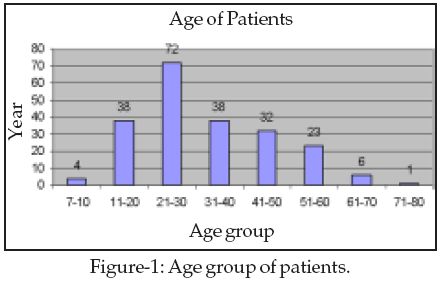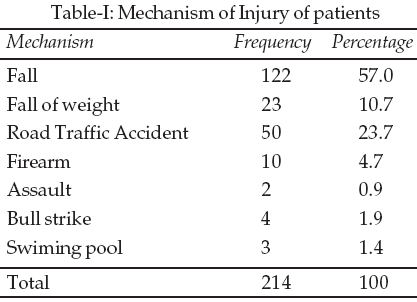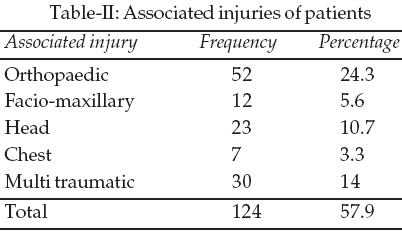|
|
||||
|
Published by : PROFESSIONAL MEDICAL PUBLICATIONS |
||||
|
ISSN 1681-715X |
||||
|
||||
|
- |
||||
|
ORIGINAL ARTICLE |
||||
|
- |
||||
|
Volume 24 |
April - June 2008 (Part-II) |
Number 3 |
||
|
|
||||
|
|
||||
|
|
||||
|
Published by : PROFESSIONAL MEDICAL PUBLICATIONS |
||||
|
ISSN 1681-715X |
||||
|
||||
|
- |
||||
|
ORIGINAL ARTICLE |
||||
|
- |
||||
|
Volume 24 |
April - June 2008 (Part-II) |
Number 3 |
||
|
|
||||
|
|
||||
Spinal Injuries: Experience of
a local Neurosurgical Centre
Zubia Masood1, Ghulam Mustafa Wardug2, Junaid Ashraf3
Abstract
Objectives: To find out the pattern of traumatic spinal injuries and their management in patients admitted to a neurosurgical unit of a tertiary care hospital in a developing country.
Methodology: All patients admitted with spinal injuries between July, 2003 and June, 2007, in the Department of Neurosurgery, Civil Hospital, Karachi, were included. Information was recorded and analysed with respect to demographic data, mechanism of injury, level of bony injury, neurological degree (complete, incomplete and intact), duration between injury and admission, associated injuries, management, hospital stay and outcome.
Results: A total of 214 patients were admitted. These included 189 males (88.3%) and 25 females (11.7%). Most affected patients (72/214 - 33.6%) were in their third decade of life, followed by second and fourth decades, 38 /214 (17.7%) in each decade. The commonest cause of injury was fall from height in 122 patients, (57.0%), followed by fall while carrying weight in 23 (10.7%), road accidents in 50 (23.4%) and gunshot injuries in 10 (4.7%) cases. Cervical spine was affected in the majority 101 (47.2%) cases followed by thoracic spinal injury, 64 cases and lumbar spine with 59 cases (27.6%). Seventy seven patients (36%) had complete neurological loss, 119 (55.6%) had partial deficit while 18 patients (8.4%) were neurologically intact. Surgery (decompression and fixation) was performed in 50 cases. Long bone fracture was the commonest associated injury. The average time between injury and admission was 6.2 days (range 0–60). Mean hospital stay was 8.4±7.6 days. Twenty three (10.7%) patients died during hospitalization.
Conclusion: This study shows that young adults, predominantly males in their most productive years of life, are especially prone to spinal cord injury. Fall from height is the most common preventable cause of spinal injury. Recognizing the pattern of spinal injury helps to identify high-risk groups which will then help us to design more appropriate preventive measures.
Key Words: Spinal injury, Pattern, Traumatic, Rehabilitation, Management.
Pak J Med Sci April - June 2008 (Part-II) Vol. 24 No. 3 368-371
How to cite this article:
Masood Z, Wardug GM, Ashraf J. Spinal Injuries: Experience of a local neurosurgical centre. Pak J Med Sci 2008;24(3):368-71.
1. Dr.
Zubia Masood, MBBS
Surgical Unit V, Civil Hospital Karachi.
2. Dr. Mustafa Wardug, DCN
1-2: Postgraduate Trainee,
3. Prof. Junaid Ashraf, FRCS, Head of the Dept.,
2-3: Department of Neurosurgery,
Dow University of Health Sciences &
Civil Hospital, Karachi - Pakistan.
Correspondence:
Dr. Zubia Masood,
B-66, Block 14, Gulistan-e-Jauhar,
Karachi - Pakistan.
E-mail: zubiamasood@hotmail.com
* Received for Publication: April 1, 2008
* Accepted: May 16, 2008
Introduction
Traumatic spinal cord injury, defined as an acute, traumatic lesion of the neural elements in the spinal canal, is one of the most devastating events with significant morbidity and mortality. It results in varying degree of sensory deficit, motor loss, or bladder/bowel dysfunction which may range from inconsequential symptoms at one end of the spectrum to total neurological loss below the level of injury at the other.
1 Annual incidence of spinal cord injury in the developed countries is 15-40 cases per million.2 The consequences of this distressing entity are all the more severe as it afflicts young members of the society, often males in the most productive period of their lives, which effects the whole family physically, mentally and economically.3Once a neurological deficit has occurred as a result of spinal injury it is often irreversible and patients who have been rendered paraplegic or quadriplegic remain so for the rest of their lives. The best treatment of this disability is that it should not occur in the first place. Hence prevention of spinal injury is the mainstay of the management. However, before any preventive strategy can be designed it is essential to know exactly the aetiology and demography of spinal injury in a particular society. Unfortunately, data regarding the demography, etiology, types and management outcome of these injuries in our society is at best scanty.
The department of neurosurgery of Civil Hospital Karachi, which is a 1670-bed tertiary care public hospital and one of the teaching hospitals affiliated to Dow University of Health Sciences (DUHS), provides services not only to the people of Karachi but also to those from the interior of Sindh and coastal regions of Balochistan. The patients who present to this hospital represent a sample of the general population of this area. Amongst other conditions it receives a large number of patients of spinal trauma and this provides an excellent database for analysis of various factors of spinal injury. The current study has been conducted to assess various parameters associated with spinal injury.
Methodology
All patients who sustained spinal cord injuries and were admitted to the Department of Neurosurgery at Civil Hospital Karachi from 1
st July, 2003 to 30th June, 2007 were part of the study. Patients with non traumatic spinal injury (e.g. spinal tuberculosis, tumors and iatrogenic injury) were excluded. The data was recorded on specially designed proforma which included age, gender, mechanism of injury, level of bony injury, neurological status (i.e., complete loss, partial deficit or intact) at the time of admission, duration between injury and admission, types of associated injuries, management during hospital stay and the outcome. Data was analyzed with the help of SPSS-10. Descriptive statistics of patients were analyzed.Results
A total of 214 patients were admitted. These included 189 males (88.3%) and 25 females (11.7%). Their ages ranged from 7 to 80 years mean ± SD (32.7±14.99). The largest number of patients, 72 (33.6%), were in their third decade of life followed by 38 (17.7 %) each, in second and fourth decades. Decade-wise age distribution of all patients is shown in Fig-1.

The leading cause of injury was fall from height in 122 cases, (57.0%), followed by road traffic accidents in 50 (23.4%). Fall with carrying weight accounted for 23 cases (10.7%) and gunshot injuries in 10 cases (4.7%) (Table-I).

The most common level of injury was of cervical spine, 101 cases (Fig-2) with C5-6 level being the commonest level involved in 68 cases, (31.7%). This was followed by 64 cases of thoracic spine injury. The twelfth thoracic vertebra was the commonest level in this region with 26 patients, (12%). There were 59 cases of lumbar spine injury (27.6%) where the commonest level was L1 vertebra in 46 (21.5%) patients. Altogether, 72 patients of thoracolumbar junction trauma were seen. Nine patients (4.2%) suffered dislocation alone while in two hundred and five (95.8%) patients, fracture of the spine was associated with some degree of dislocation. Classification of neurological severity disclosed 77 patients who had complete loss, 119 had partial deficit while 18 had completely intact neurological status. Fifty patients (23%) required surgical treatment which comprised of decompression and instrumental fixation while five patients (2.3%) were managed with traction alone. Isolated long bone fracture was the commonest associated injury. It was present in 52 patients (24.3%). This was followed by multi traumatic injuries including head, maxillofacial, orbital, dental, thoracic and abdominal and other orthopaedics injuries (Table-II). The average time between injury and admission was 6.2±13.7 days (range 0–60). Mean hospital stay was 8.4±7.6 days (range 1-39). Twenty three (10.7%) patients died during hospitalization.

Discussion
Traumatic spinal cord injury, with its long term sequelae and life long rehabilitation that is required in its management is an important health care problem in Pakistan. It is not only associated with significant morbidity and mortality but also results in economic and social burden. The mortality until the Second World War has been reported to be as high as 60-80%, since then there has been a dramatic decline in mortality rate due to improved management. Despite optimal medical management life expectancy amongst patients sustaining spinal cord injury remains low.
4-6 Spinal injury may affect population in any age group. Understanding the relevant aetiological factors in different age groups allows introduction of better methods of prevention.7 In our study 148 patients, (69.1%), were between 11 and 40 years of age with most common affected age group being the third decade with 72 cases (33.6%). The mean age of 32.7 ±14.9 is similar to that seen in other studies.7-11 Significantly higher number of males sustained spinal injury (88.3%) compared to females, (11.7%). This is similar to other studies from our part of the world such as Bangladesh, Jordan and Turkey.8-10 This shows that men in their most active and productive period of life are affected by spinal injury, which adds a serious economic loss to the community. The great difference between the incidence of spinal injury in men and women in our part of the world is most likely due to the fact that females mostly do not go out to work and remain indoors.Falling from a height was the leading cause of injury in our study accounting for 122 cases, (57.0%), which is comparable to the studies from other parts of the world such as 59% from Romania,
12 55% from India,13 48% from Nigeria,14 and 43% from Thailand15 and Bangladesh.8 Fall from height alone and while carrying weight is due to occupational trends in our country (agriculture, labour work). According to the World Health Organization data, road accidents claim some 6,00,000 lives each year worldwide and twenty-five times this number, that is over fifteen million, are injured.16 Road traffic accident was the major cause of spinal injury world wide especially in developed countries.17-19 In our series of cases, it was the second commonest cause 50 (23.4%). It is generally accepted that the most injured spinal level is at fifth and sixth cervical vertebrae as this level has the greatest range of flexion-extension stress and is therefore most susceptible to trauma.8,20,21 This was also seen in our study with 68 C5/6 injuries in 101 cases of cervical spine trauma.Isolated long bone fracture was the commonest other injury associated with spinal injury and was present in 52 patients, (24.3%), followed by other injuries including head, maxillofacial, orbital, dental, thoracic, abdominal and other orthopaedic injuries (Table II). The average time between injury and admission was 6.2±13.7 days (range 0–60). This long delay was due to the fact that many patients came from distant places and were referred from basic health units of small towns where proper neurosurgical care was not available.
Conclusion
The results of this study have shown that young adults, predominantly males in their most productive years of life, are especially prone to traumatic spinal cord injury. The management of these patients presents formidable challenges which include intensive care, surgery and life long rehabilitation, and the long term economic and social impact on the patients and their families. Recognizing the pattern of traumatic spinal cord injuries, relevant aetiological factors and identification of high-risk groups will be helpful in designing better methods of prevention.
References
1. Solagberu BA. Spinal cord injuries in Ilorin, Nigeria. West Afr J Med 2002;21(3):230-2.
2. Sekhon LH, Fehlings MG. Epidemiology, demographics, and pathophysiology of acute spinal cord injury. Spine 2001;15(24 Suppl):S2-12.
3. Butt RM, Shams S, Habib A, Raja IA, Sarwar A, Ahmed A. Epidemiology of Spinal Injuries. Pak J Neurol 1997;3(1):20-5.
4. DeVivo MJ, Kartus PL, Stover SL, Rutt RD, Fine PR. Cause of death for patients with spinal cord injuries. Arch Intern Med 1989;149(8):1761-6.
5. Freed MM, Bakst HJ, Barrie DL. Life expectancy, survival rates, and causes of death in civilian patients with spinal cord trauma. Arch Phys Med Rehabil 1966;47:457-63.
6. Hartkopp A, Brùnnum-Hansen H, Seidenschnur AM, Biering-Sùrensen F. Survival and cause of death after traumatic spinal cord injury. A long-term epidemiological survey from Denmark. Spinal Cord 1997;35:76-85.
7. Augutis M, Levi R. Peadiatric spinal cord injury in Sweden: Incidence, etiology and outcome. Spinal Cord 2003;41:328-36.
8. Hoque F, Grangeon C, Reed K. Spinal cord lesions in Bangladesh: An epidemiological study 1994-1995. Spinal Cord 1999;37:858-61.
9. Otom AS, Doughan AM, Kawar JS, Hattar EZ. Traumatic spinal cord injuries in Jordan: An epidemiological study. Spinal Cord 1997;35:253-5.
10. Karamehmetog SS, Nas K, Karacan I, Sarac AJ, Koyuncu H, Ataog S, Erdogan F. Traumatic spinal cord injuries in Southeast Turkey: An epidemiological study. Spinal Cord 1997;35;531-3.
11. Oureshi AA, Irfan A, Memon MA. Spinal Injuries: A Prospective Study Biomedica 2001;17:27-9.
12. Soopramanien A. Epidemiology of spinal injuries in Romania. Paraplegia 1994;32:715-22.
13. Chacko V, Joseph B, Mohanty SP, Jacob T. Management of spinal cord injury in a general hospital in rural India. Paraplegia 1986;24:330-5.
14. Okonkwo CA. Spinal cord injuries in Enugu, Nigeria: Preventable accidents. Paraplegia 1988;21:12-8.
15. Kovindha A. Spinal cord injuries in Maharaj Nakorn Chiang Mai Hospital: 5 years retrospectively. Chiang Mai Med Bull 1985;24:179-85.
16. Downing A. International overview of road safety In: International workshop on Prevention and control of traffic accidents and injuries (24 Nov-3 Dec. 1992). New Delhi, India. 4-12.
17. Chen CF, Lien IN. Spinal cord injuries in Taipei, Taiwan: 1978-81. Paraplegia 1985; 23: 364-70.
18. DeLilla T, Eddy S, Cooper T, Hensley K. Five year summary on spinal cord injuries statistics, Florida, 1990.
19. Garcia-Renses J, Herruzo CR, Martinez-Moreno M. Epidemiological study of spinal cord injury in Spain 1984 - 1985. Paraplegia 1991;28:180-90.
20. Martins F, Freitas F, Martins LL, Dartigues JF, Barat M. Spinal cord injuries: Epidemiology in Portugal’s central region. Spinal Cord 1997;35:574-8.
21. Hagen EM, Aarli JA, Gronning M. The clinical significance of spinal cord injuries in patients older than 60 years of age. Acta Neurol Scand 2005;112:42-7.
HOME | SEARCH | CURRENT ISSUE | PAST ISSUES
Professional
Medical Publications
Room No. 522, 5th Floor, Panorama Centre
Building No. 2, P.O. Box 8766, Saddar, Karachi - Pakistan.
Phones : 5688791, 5689285 Fax : 5689860
pjms@pjms.com.pk